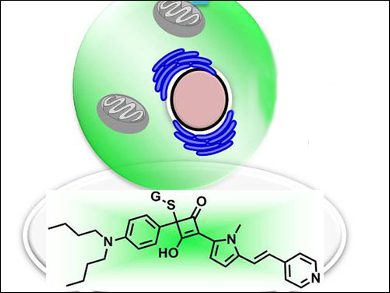Apoptosis is a form of programmed cell death. It plays an important role in development and tissue homeostasis (the cell proliferation and death keeping living tissues in a steady state). The dysregulation of these processes can lead to diseases such as autoimmune and neurodegenerative disorders, as well as cancer. A consequence of apoptosis is the reduction of the antioxidant glutathione (GSH), which regulates cellular redox processes. As such, developing probes for monitoring GSH and other biological thiols in cells is of importance in cell biology.
Kaustabh K. Maiti, Ayyappanpillai Ajaghosh, and colleagues, Council of Scientific & Industrial Research–National Institute for Interdisciplinary Science and Technology (CSIR-NIIST), Thiruvananthapuram, India, have developed squarine-based probes (Sq) that rapidly detect thiols such as glutathione. The probes shift from red emission (λ = 640–700 nm) to green emission (λ = 540–580 nm) in the presence of thiols (pictured). The researchers demonstrated that this reaction is reversible by oxidizing the thiol with hydrogen peroxide, and that the Sq dye forms a ratiometric product with the thiol by mass spectrometry (MS).
The team tested the response of the Sq dye in cells to monitor apoptosis using fluorescence microscopy. They showed a high green-to-red fluorescence intensity ratio in healthy cells, which decreases upon the induction of apoptosis. The results are in agreement with standard kits that measure GSH levels in cells.
- A Ratiometric Near-Infrared Fluorogen for the Real Time Visualization of Intracellular Redox Status during Apoptosis,
Giridharan Saranya, Palapuravan Anees, Manu M. Joseph, Kaustabh K. Maiti, Ayyappanpillai Ajayaghosh,
Chem. Eur. J. 2017, 23, 7191–7195.
DOI: 10.1002/chem.201700839




